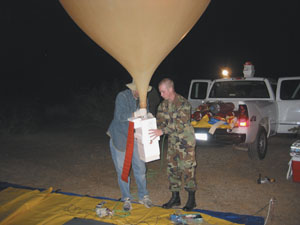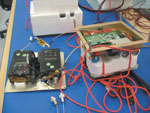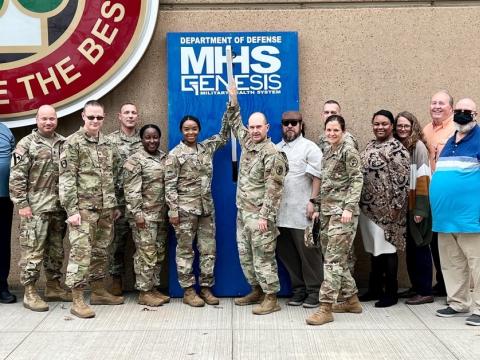Near Space Fills Communications Gap
Extended connectivity emerges out of thin air. 
Members of the 13th Air Support Operations Squadron launch an AN/PRC-148 payload during test flights prior to the Combat SkySat demonstration in March. The tests helped determine the ideal operational altitudes for the radios.
The combination of a low-tech platform and a high-tech radio is extending beyond-line-of-sight communications from 10 miles to more than 400 miles. The approach employs small hydrogen balloons that are sent into the near-space realm—defined as from 65,000 feet to 325,000 feet above Earth—toting two AN/PRC-148 radios that relay ground-to-ground, air-to-ground and ground-to-air voice and data communications. Although the capability was developed to address a combat-mission need statement and is scheduled to be deployed to theaters of operation in December, the benefits of this technique also could extend to homeland security as well as emergency relief efforts such as assistance in the aftermath of Hurricane Katrina.
The U.S. Air Force Space Battlelab, Schriever Air Force Base,
“The mission we were attacking was the needs of the tactical air control parties [TACPs]—the guys who are on the ground. The TACPs have to have line of sight with airplanes and/or their fellow ground members to communicate with a handheld PRC-148 radio. We said, ‘Let’s see if we can shorten the time chain for passing information.’ So we took a couple of PRC-148 radios, pretty much duct-taped them together and made them a trans-receiver if you will,” Col. Rhodes explains.
Space Data Corporation,
Persistent connectivity can be accomplished by a technique called constellation replenishment, Col. Rhodes explains. “Depending on the winds aloft, your area of regard may be traversed by the balloon in from 3 to 12 hours. So if the current balloon is beyond the area that you’re interested in, you launch another balloon. These balloons last, and in the commercial effort in
When connectivity cannot be maintained or is no longer needed, a parachute-release system brings the radios to Earth where they may be recovered. Free of the weight, the balloon ascends until it bursts just like a weather balloon. However, work is currently underway on a new recovery system that involves a glider that could be programmed to deliver the radio or sensor payload to a specific location.
To examine the feasibility of the radio-bearing balloons in military applications, the battlelab conducted a proof of concept demonstration in March called Combat SkySat.
“Space Data has their own repeater in the 900-megahertz range, and the [circuit] card weighs ounces versus 5 pounds for two PRC-148s. So that’s how we see the future: an even more disposable circuit card versus full-blown flying two radios hooked together,”
Prior to Combat SkySat, the battlelab team conducted eight test flights because the AN/PRC-148 had never been used at high altitudes and the team was concerned it might not operate in the thin-air environment. Although performance was good, some overheating took place in the 95,000-foot range, the colonel says, so the engineers decided to keep the balloons in the 65,000- to 75,000-foot range for the demonstrations.
Three communications scenarios were explored during the three-day event: ground to ground, air to ground and ground to air. Several communications bands were examined, including AM, FM, ultrahigh frequency and very high frequency. Both secure and nonsecure modes also were studied.
Four teams traveled from Phoenix: One headed west toward San Diego; one traveled east toward Deming, New Mexico; one went north toward Flagstaff, Arizona; and one proceeded south toward the Mexican border. The demonstration proved that connectivity could be extended from the usual 10 miles for line-of-sight communications in that type of terrain to more than 400 miles. “Also, it doesn’t matter how many operators you have on that network. You could have 100 operators on there and they’re all using that communications frequency relay, and everybody would be connected in that particular footprint,”
The colonel admits that even the battlelab staff did not expect to be able to maintain the communications link at a distance of 400 miles. The radios were used at a relatively lower power setting, 3 watts, and Thales estimated that the theoretical communications range at that wattage would be around 300 miles. “We think we could have pushed much, much farther, but we had teams going all the way toward
To assess communications quality, the battlelab team used four categories: loud and clear, good and readable, weak but readable, and weak and unreadable. Even at more than 400 miles, the signals were still good and readable,
In addition to the ground teams, the effort showed how radio-equipped balloons can support tactical air patrol parties. A-10s, F-16s and Joint Surveillance Target Attack Radar System aircraft were employed, and the battlelab team proved that not only were air-to-ground and ground-to-air communications possible but also users on the ground could communicate with aircraft on the ground. This is “a very nice capability,”
The team also operated in secure mode for the air-to-ground link, and because the radios on the balloons are only repeaters, cryptology equipment is not necessary. “So if we don’t get them back, for whatever reason, it’s not as big a deal as if you’re flying actual crypto material,” the colonel offers.
Ron Irwin, senior systems engineer, Scitor Corporation, worked with the battlelab on the demonstration, and he emphasizes how this technique supports operational responsiveness. “With satellites, you can’t decide that you’re going to launch another satellite right now,” he says. “And we’re just touching on the capabilities of this kind of technology. This is a capability that the field commander doesn’t have to ask anybody’s permission to use. He just floats communications whenever he needs to and at a price that’s so cheap it’s going to revolutionize beyond-line-of-sight communications.”
 |
| For Combat SkySat flights, Space Data Corporation’s payload, which includes a tracking device, parachute and tethering system, was integrated with two AN/PRC-148 radios set to the repeater mode. |
Although Combat SkySat was a success, members of the battlelab already are looking to the future. The colonel points out that while using a balloon as a platform has several advantages, there is still room for improvement. Persistence is one problem the team is still trying to solve, for instance. Free-floating balloons are only as persistent as winds allow. When a vehicle is developed that can maintain stationkeeping in near space, it will be a significant breakthrough, he states.
The potential for commercial uses for near-space communications will likely drive continued improvements. The technique already is being used commercially in
And ability to service a handful of users has military applications as well, Col. Rhodes points out. Teams of special operations forces need the ability to communicate, and the near-space approach is one option, he states.
Other possible applications for the capability include homeland defense or disaster relief. Although the battlelab’s primary mission is to determine whether commercial products can fill a military requirement,
Maj. Steven G. Staats, USAF, deputy director, initiative demonstrations, Air Force Space Battlelab, agrees that the applications for this capability are far-reaching. While satellite communications enable connectivity at the strategic level, the capability demonstrated during Combat SkySat will be useful at the tactical level. “When you look at the overall communications need, whether it’s the Defense Department or the Department of Homeland Security, there’s an integrated approach, and you have to identify the effect you need and then identify the system to provide it. This will be one of those systems in your quiver that you could choose to meet particular needs,” the major says.
Col. Rhodes agrees. “We see this fitting in very nicely as a subset of the Joint Warfighting Space concept in that we’re able to bring space effects to the tactical and operational level of war, which will relieve our strategic assets from doing those kinds of missions so they can do what they’ve been designed to do. Right now, they’re over-tasked and we can’t get enough UAVs [unmanned aerial vehicles] in the air to provide all the information that we want on the battlefield. So as we do our battlefield preparations, we see near-space assets as filling a part of that overarching concept of bringing space effects to the warfighter,” he states.
In addition to voice communications, Maj. Staats relates that data can be relayed. The AN/PRC-148 can support data rates equivalent to a telephone modem. During the demonstration, the battlelab team showed that mapping data could be relayed from the TACPs using handheld devices. Currently available systems can relay information at considerably higher speeds, he says, and the battlelab is examining how to relay streaming video in the future.
Plans for the future also call for exploring other types of sensors that could be flown into near space. The battlelab expects to examine these during fiscal year 2006. In addition, near-space capabilities will be part of Joint Expeditionary Force Experiment 2006 next spring.
Col. Rhodes emphasizes that not only is the system joint but so is the effort to develop near-space capabilities. The Air Force Space Battlelab started its efforts in this arena by working with the U.S. Army Space Battlelab. It later found out that the U.S. Navy was exploring the topic. As a result, the Joint Near Space Council has been established and currently includes representatives from the Air Force, Army, Navy, Coast Guard and U.S. Special Operations Command. Throughout late summer and early fall, the group worked out memorandum of understanding details, the colonel says, to delineate responsibilities and ensure members are not unnecessarily duplicating efforts. The council’s first meeting took place in August, and the next meeting is scheduled to occur this November.
Web Resources
Space Data Corporation: www.spacedata.net
Thales Communications Incorporated: www.thalescomminc.com/section_about_us.asp


